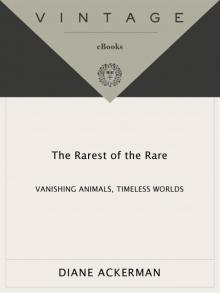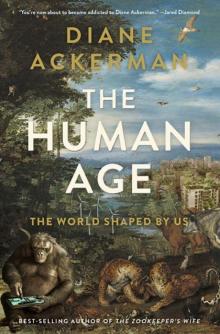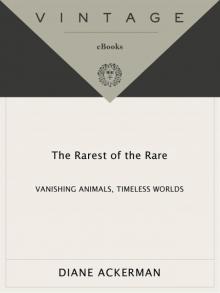- Home
- Diane Ackerman
The Rarest of the Rare Page 7
The Rarest of the Rare Read online
Page 7
As we float down the river, we occasionally smell smoke in the air. Though we are miles away from the sites, we are smelling the devastation of the rain forest, smelling the burning of huge tracts of forest. If the destruction continues at its current pace, all of the rain forest will disappear forever in about forty years. Mining projects, rubber plantations, massive ill-fated cattle-growing projects, hydroelectric dams, highways, and an attempt to burn and dominate the land just because it is frontier and human beings can’t abide an unowned space—all have contributed to the destruction of entire ecosystems. Species are going extinct in the rain forest that have not even been named yet. As Iain points out, “We are probably the last generation to have the opportunity to conserve the species of the Amazon forest.… Today we stand at the brink of disaster in Amazonia … a mass extinction of species—one even greater than when the world lost its dinosaurs.”
As the day fades, we return to our Zodiacs and start back down the river, which smells different in the evening than in the morning. In the morning, the oxygen is low and the air lightly perfumed. But in the evening, the air sizzles with oxygen and smells of sedge and damp amber. Pink auroras gush across the sky as darkness falls. With a lantern aimed low at the shore, we search for the eyes of caymans, Amazonian relatives of alligators. To get their attention, we make a mating or juvenile distress call, a syncopated grunting: Uh! Uh! Uh! Then we float quietly and wait. To see nature you must be willing to cut the motor and drift, to follow wherever the current leads. But this is tough for goal-oriented people. Some people in my boat chat compulsively, polluting the silent grandeur of the forest. At first I thought they were ignoring the wild, rich sounds of bird, leaf-fall, river, animal, and the august silence, but in time I began to think that it might be the opposite. Talk makes such small shapes in the teeming wilderness of Nature, small shapes in the formless clamor of the universe, but they are shapes for those who need them. They are planks to the shore. “Sshh. Listen,” someone says gently, and everyone quiets down for a few minutes, letting the sounds of night wash over them. The steady beat of a frog sounds like someone rubbing a taut balloon. Corrusha, a bird called coruja calls, a samba in the word. The shore flashes with fireflies, and then a click beetle with two headlights flies over the boat. Our flashlight is reflected in the small revolving campfires of an owl’s eyes. At night, there are many mysterious, coal-burning eyes. The reason they seem to shine so eerily is that just behind the retina of nocturnal animals there is a reflective membrane called the tapetum, which helps these creatures see in the dark. Light bounces off of its shiny surface. These live, burning embers in the forest remind us that we are burning, too, from the distant chaos of the sun. An osprey catches a fish and then tilts its beak up so it will be more streamlined when it flies. Cormorants feed near the shore; each has a sort of mousetrap in its throat, the better to stalk fish underwater. Terns swoop in front of us, gliding, then diving in an accelerated stall, careening up into a chandelle, an aerobatic half-loop that ends with the tern rolling over on one shoulder, gaining speed, climbing, and diving again in a bout of aerial sighing and swooning. Bony-tongued fish, aruaná, jump to feed. Caboclo fishermen still ply the water in bark canoes, which they steer from the front. Their black paddles are exclamation points dipping into the river.
Fifteen yellow butterflies dogfight and gambol in the green, sedgelike grass of the shore. An Amazon dove whistles. Then a fork strikes a crystal goblet, as if someone were earnestly calling the jungle to order. A flock of parakeets sounds like wet rope twisting into a chirpy screech. Toucans yap like distant dogs. Here and there a low, shallow bark canoe sits on the shore, awaiting its paddler, on business somewhere in the forest. A hawk with bright yellow feet and beak perches on a dead tree branch. Water plashes down a bank from an oxbow lake nearby. When a Brazil nut tree loses two leaves, they fall gently and hit the ground with a hollow clatter. Wheee!, a hawk calls like a child with a kazoo. Wheee! Soon the rest of the kindergarten band joins in with sandblocks, bottles, tin pans, bells, as different birds take over and the crickets begin to throb and itch with song. An Amazon bird related to the chicken makes a quaking buzz. A trogon calls, You! You! We float past a hematanthus tree with bold white flowers, whose alkaloids are used in heart medicine. Tinkling wind chimes fill the air; then comes a howling trill. A spring door slapping and creaking on its frame is a frog.
The new moon makes a slender white canoe above the darkening trees. Bats scout overhead. Iain, knowing of my fondness for bats, tells me that once he saw a bat-eating fish that leaped out of the water, grabbed a bat, and dragged it under. Now the bottle band includes yowling and banshee moans. A white planet, southeast of the moon, floats low over the forest like a shard of ice. In the surging darkness, lights bloom on the river: a single yellow lightbulb from a house; the whiter light of a Zodiac’s lantern; the distant flash of a camera where Mo and others are fishing; the twittering greenish-yellow light of fireflies, our ship lying at anchor downstream, lit like a miracle play. In my cabin, deliciously exhausted from the sheer sensory whelm of the day and eager for the days to come, I brew a pot of casca preciosa and sip its sweet scented tonic as the ship rocks gently on the ancient river. Then I fall into the well of sleep. For once, dream is the same as the waking world: there I again snorkel in the river by moonlight, hear the muttering of monkeys, and follow a trail of leaf-cutter ants hauling home their small burdens along corridors of scent.
SHORT-TAILED
ALBATROSSES
Coming, going, the waterfowl
Leaves not a trace,
Nor does it need a guide.
—Dōgen (a Japanese Zen master)
This world of ours,
To what shall I compare it?
To the white wake of a boat
That rows away in the early dawn.
—Shami Mansei
The first time I heard the word “Torishima” I was on a ship in the Antarctic, cruising through a garden of sparkling ice, bound for the bird-clotted cliffs of South Georgia. Peter, a painter and ornithologist, was delivering one of his ebullient lectures on albatrosses, his favorite seabirds, some species of which we would soon be climbing tussock-covered hills to view. A short, fair-haired man in his early forties, with a carefully trimmed mustache and beard and the wiry build of a rock climber (seabirds often nest on cliffs), Peter began in a whisper, with the sincerity of someone accidentally overheard at his devotions:
“The open ocean is to birds what space is to mankind—the last great frontier. For birds it poses the harshest, most unyielding environment on the face of the planet, an environment that covers nearly two thirds of the world’s surface. Yet it is possible even thousands of miles from land to go to the rails of a ship, look seaward, and see birds. But these are not ordinary birds; these are seabirds. Out of all the world’s seabirds, there is one group that is a cut above the rest, one group that is peerless, one group that fills me with awe. They are the most pristine life-form. Those gentle giants are albatrosses. Their kingdom is not one of hillsides, forests, or meadows but is an ever-changing seascape of blue, green, and white, whose moods are unpredictable. Over these vast tracts, albatrosses eke out a precarious and itinerant life. They are the ocean’s nomads.”
In a British accent lightly tempered by his encounters with a variety of cultures during many years at sea, Peter continued, with the heightened emotion of a painter describing his favorite model. Large, porcelainlike, and stately, albatrosses are among the most beautiful birds. He told us that he had seen every species of alba tross in the world except one—the loveliest and most startling—the short-tailed albatross, a nearly extinct bird with a tragic history, which breeds on only one small, remote, storm-tossed Japanese island dominated by an active volcano. He had been trying to get there for ten years; at one point, he managed to sail to within two hundred miles of Torishima, but weather and circumstance prevented him from landing. “Torishima.” He pronounced the island’s name with his eyes closed, letting the
word pour like a fresh breeze through the doldrums of his mouth. “To-ri-shima,” he said again, with deep reverence and longing. Slides of albatrosses appeared in the darkness, as magically as drawings in the caves at Altamira. As the island’s name drifted across the room like an incantation, I thought of life’s wonderful mosaic, how miraculous and subtle the world’s creatures are, and how treacherous human beings can be to the animals we share the planet with.
The short-tailed albatross once clouded the skies from Japan to California. It was the most abundant albatross in the North Pacific and the primary source of nonmammalian protein in the diets of Aleuts, Inuits, and other North American Indians all the way from the Aleutians to Baja California. In barely a hundred years, plume hunters slaughtered almost every single one of them. In a seventeen-year period alone, five million were killed to stuff mattresses and quilts. When the U.S. Fish and Wildlife Service surveyed fifteen thousand square kilometers of the Bering Sea between 1975 and 1982, they found only one short-tailed albatross. The entire world’s population of short-tailed albatrosses had dropped to approximately ten birds; they had probably come closer to extinction than any other animal on earth. Those that survived did so only because they found a hiding place on Torishima that was virtually inaccessible to humans. In 1962 the Japanese government declared those rare, short-tailed albatrosses a national monument—not the island they inhabit but the birds themselves. Now, about four hundred of them remain: there are about two hundred nesting on Torishima and two hundred immature birds at sea. Although the species has rallied dramatically, it is hanging on to existence by a thread; indeed, despite conservation efforts, it may become extinct in our lifetime. What could be more important than to behold these seabirds, to celebrate their beauty and uniqueness? I knew I would have to go to Torishima. Peter and I began planning our trip that evening.
Torishima (“bird island”) lies five hundred eighty kilometers south of Tokyo, far from any other land, out in the storm-scoured Pacific. Visiting the island would mean getting special permission, since it has been declared off-limits by the Japanese government, in part to protect the birds, but also because it is an active volcano; an eruption in 1902 killed all 125 of the island’s last remaining settlers. Our best hope, we decided, was to join forces with Hiroshi Hasegawa, an extraordinary Japanese ornithologist, who has devoted his life to saving the short-tailed albatross and single-handedly brought their plight to the attention of his government. We would have to go in typhoon season, when the birds were nesting. Apparently, the winds pick up savagely from the northwest in typhoon season, and the only break in the island’s stone jaws is one small cove in the northwest corner. There is no beach on Torishima, only volcanic cliffs and sharp black boulders of frozen lava, against which a boat could be tossed and shattered, so we might have to swim ashore, braving sharks and jellyfish. Then we would have to climb the volcano.
Sitting in the lounge of the ship, as it dipped into the long steep swells of the Antarctic sea, Peter and I grinned. It was irresistible. After all, it was his last albatross. For me, it would be a great quest in search of what is rare and beautiful and nearly extinct.
Ten months and much three-person planning later, we fly to Tokyo to meet Hiroshi, who by now has become an epistolary friend. After going through Immigration at Tokyo’s International Airport and listing our final destination in Japan as “Torishima meteorological station (abandoned),” we claim luggage and pass through smoky glass doors into the main terminal. The first people we see are a slender Japanese man in his early forties, accompanied by a younger man and woman—Hiroshi and his two graduate students, who swoop down on us like benign falcons, introduce themselves first in the Japanese style, with bows, and then Western style, with handshakes. Peter and Hiroshi look at each other and grin; slender and athletic, with mustaches and beards trimmed identically, they look like Eastern and Western versions of the same species.
“Birders are the same the world over,” Peter says, laughing, as we hoist our heavy knapsacks and cases. “We already know a great deal about each other.”
One of the things he knows is that birders believe wholeheartedly in the tonic value of ritual, ceremony, and celebration. On the eve of the quest, a special banquet has been planned. As encumbered as an Everest expedition, the five of us set out by bus and two subways, heading across town to the stop for Toho University, where Hiroshi teaches. Climbing out of the tunnels, we enter a world of narrow streets where houses and stores fit together like pieces of a parquet floor that sprawls up as well as along. Night is falling, and hundreds of colored neon lights throb from pachinko parlors, restaurants, and shops. Our travel-weary eyes stretch wide open, to swallow all the strange new shapes, patterns, and changing colors. It is like walking through the branches of a heavily ornamented Christmas tree. In ten minutes, we arrive at a restaurant decorated with photos of sumo wrestlers. A woman with round, smiling cheeks, eyeshadow the color of wisteria, and a bright red mouth drawn smaller than its natural outline greets us at the door, and is obviously pleased to see Hiroshi.
Bowing slightly, she says to us, “Dozo” (“Please”), and sweeps a hand forward in the universal gesture of Won’t you enter. We slip out of our shoes and leave them at the door among many other pairs perched on the bamboo matting like so many nesting grouse, and follow Hiroshi to a low table in a far corner, where thin pillows have been arranged on the floor.
Peter and I exchange a what-do-you-think-we-should-do-now look and observe our hosts. When the three sit down on their heels, hands resting on their thighs, we do the same. This is the traditional style of sitting, but some of the young Japanese around the room seem to be lounging, American style, one blue-jean-clad knee bent, the other leg stretched out at an angle. Healthier and longer-legged, the new generation of teenagers sometimes finds the traditional style too confining both physically and mentally.
The owner of this small family restaurant is the widow of a well-known sumo wrestler. Hence the decor—calendars of wrestling championships, photographs of wrestlers in action, trophies, and wrestling belts. The menu also favors dishes preferred by sumo wrestlers, but a waitress places in front of each of us a gondola-shaped dish containing three sushi delicacies—a large, thick, chewy sea snail; a pile of ropy white cod’s testicles; and a fried squid. Peter and I look at each other, then at Hiroshi, whose eyes are burning with mischief.
“Looks good, doesn’t it, Peter?” I say, rubbing my hands together. “Can’t wait to try it. Never seen a snail as big as that, have you? Looks like a small palomino.”
“No, I can’t say I have. And it’s amazing the way they have it arranged—as if it’s running.”
“And the head is so interesting.”
“Yes,” he says slowly.
I lift the snail in my chopsticks, thinking for a moment that it lacks only a belt around its waist to be a sumo snail, and pop it into my mouth, chew its sweet rubbery mass many times, and smile approvingly to Hiroshi. Then I start in on the creamy, warm cod’s testicles.
While we talk of local land birds, a new species of albatross (the “Amsterdam”), which was recently discovered, and how the short-tails are faring, Hiroshi gives Peter chopstick lessons. Fumbling at first, Peter soon lifts the chopsticks to his mouth like a bill and moves the bottom one as an albatross would its lower bill. Hiroshi laughs and does the same, and before long the two of them refine the movement and begin quietly clacking. It is a very esoteric ornithological pantomime, which greatly amuses our hostess, who arrives to light a hot plate in the center of the table. This she tops with a big bowl of chanko nabe, a stew of tofu, chicken, vegetables, and indigestible white noodles (“for cleaning out the body”). This is a lighter version of the typical sumo wrestler’s diet, sumo nouvelle cuisine as it were. If we were in training, we would get up early, eat lightly, work, and devour our heavy, fatty meal late at night before going to sleep to ensure that our weight reached the three or four hundred pounds a sumo needs to be in top fighting shape. After a few
minutes of sitting on our cramped feet, in the Japanese style, we resort to crossing our legs. Hiroshi’s English, though halting at times, is surprisingly good. Neither Peter nor I speak any Japanese at all. But the men share a common language of birds and soon are comparing notes in pantomime and in Latin.
“Kampai!” Hiroshi toasts, lifting his glass of beer.
“To Torishima, and the albatrosses,” Peter offers.
“Ahodori,” Hiroshi corrects him, using the Japanese word for albatross. “It means ‘fool bird,’ “ he says, writing the word down in Japanese, first in the sophisticated hiragana style, then in the simpler glyphs of katakana Japanese—the same bird in an alternate plumage of characters.
“Why are they always thought to be fool birds?” I ask him. Gooneybirds they’re sometimes called in English.
Stroking one hand lightly down his beard, he says, “I think perhaps because of how they sometimes look when they land.” He makes a tumbling motion with his hands in the air. “But maybe also because they were fools not to fly away when humans came with …” He holds an invisible baseball bat in his two hands. “The men murdered one ahodori, another, and another, and the rest of the birds didn’t understand what was happening, they didn’t fly away. Their killers thought: What fools these birds are, they’re so easy to kill.”
A bird of such gentleness and beauty was doubly prized by feather hunters, whose trade probably began casually—fishermen gathering feathers at bird colonies on islands they visited. But toward the end of the last century, when Japan began conducting a lot of overseas trade, feathers became all the rage in Europe and the United States. An albatross has between fourteen thousand and sixteen thousand feathers, most of which are small, soft, and downy. There are only ten large feathers per wing, twenty large wing feathers for the whole bird, and as many as twelve tail feathers. So, out of something like fourteen thousand feathers, only a handful could be harvested as quills for pens, or for hats. But the rest made soft, warm stuffing for mattresses and pillows. During a typical year around the turn of the century, Japan exported 380,000 kilograms of feathers, and the trade declined only when the country started to run out of birds.

 A Natural History of Love
A Natural History of Love The Rarest of the Rare: Vanishing Animals, Timeless Worlds
The Rarest of the Rare: Vanishing Animals, Timeless Worlds The Zookeeper's Wife: A War Story
The Zookeeper's Wife: A War Story The Human Age: The World Shaped by Us
The Human Age: The World Shaped by Us A Natural History of the Senses
A Natural History of the Senses One Hundred Names for Love: A Memoir
One Hundred Names for Love: A Memoir The Rarest of the Rare
The Rarest of the Rare